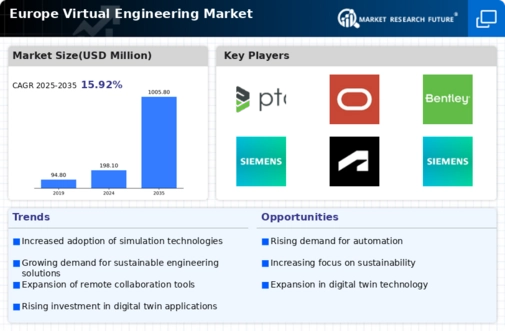The Europe Virtual Engineering Market is characterized by a dynamic and competitive landscape where various players are developing innovative solutions to meet the growing demand for virtual engineering services. As industries increasingly adopt digital transformation strategies, the integration of virtual engineering technologies into product development and manufacturing processes is gaining traction. Companies are focusing on enhancing their digital engineering capabilities to streamline processes, reduce costs, and improve product quality. This competitive insight into the Europe Virtual Engineering Market reveals that businesses are not only competing on technological advancements but also on offering tailored solutions that cater to the specific needs of various sectors, including automotive, aerospace, and manufacturing.
Market players are differentiated by their strategic partnerships, investments in research and development, and ability to leverage advanced technologies such as artificial intelligence and cloud computing.PTC has established itself as a leader in the Europe Virtual Engineering Market through its robust suite of innovative solutions tailored for a variety of industries. The company's strengths lie in its comprehensive product lifecycle management systems, particularly its flagship software that facilitates digital thread capabilities. PTC's strong commitment to research and development has enabled it to continuously evolve its offerings, ensuring that clients benefit from cutting-edge technology. With a solid market presence in Europe, PTC has formed strategic partnerships with system integrators and industry leaders to enhance its service delivery. Moreover, PTC's focus on customer-centric solutions has cemented its reputation as a reliable partner for businesses looking to adopt virtual engineering practices, thereby solidifying its position in the competitive landscape.
Oracle has made a significant impact on the Europe Virtual Engineering Market by offering diverse solutions tailored to the specific needs of engineering and manufacturing sectors. The company provides advanced cloud-based platforms that support project management, design collaboration, and data analytics while enhancing productivity and efficiency in engineering processes. Oracle's strengths include its extensive portfolio of enterprise resource planning and supply chain management solutions, which are seamlessly integrated with virtual engineering capabilities. The company's market presence in Europe has been strengthened through strategic mergers and acquisitions, allowing it to enhance its technology stack and expand its customer base. Additionally, Oracle fosters innovation through continuous investment in technology, emphasizing the development of tools that support digital transformation in engineering environments, making it a formidable competitor in the region.























Leave a Comment